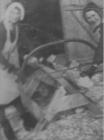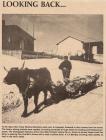1
As is the case with Newfoundland's history in general, the early story of forest exploitation is tightly linked to the sea. The first users of our woodland resources were fishermen, who sought wood near the sea for firewood, boatbuilding materials and lumber for houses, stages, and wharves. In fact, the coastal forest, for at least three miles inland was reserved by government to serve the needs of those engaged in the inshore fishery. The resources were considered common property, available to anyone, this was known as the "Tenurial Factor".3
Both softwoods and hardwoods were used for fuel, with balsam fir, black spruce, and white birch being the most common. Hardwoods were also valued as fuel for export due to their high value. The harvesting of firewood was a very important chore as wood was the only source of fuel for heat and cooking.5
Until the introduction of the power saw in the 1950's, firewood was harvested by axe or saw. Once fallen, it had to be trimmed of its branches, stacked in piles, and then transported home by way of hand sled, oxen, horse or by being towed or dragged with a towing rope. A strong back was much needed using this form of harvesting! Now the logs are cut into smaller sizes using a wood horse, cleaved, and packed away so it could be seasoned or dried. The use of green wood causes creosote buildup and often led to chimney fires. Dry wood was used to make splits or kindling, and birch rind was kept to assist with starting the fires.7
Small fishing boats and dories came from nearby fishing settlements at the mouth of Bay d'Espoir and Hermitage Bay. Their visits were generally less than a week's duration. Among their demands was timber for boat building, home and outbuilding construction, and fuel, particularly birch for the winter. The latter was generally obtained during the autumn visit. Any trips made earlier in the year were to obtain timber used in the maintenance of their premises. Because of boat size, the logs had to be rafted and towed instead of being loaded aboard.Larger vessels were usually loaded within a week or two, depending on the crew size. After the 1860's fuel became increasingly the dominant cargo and by the 1920's it made up nearly all of the schooner loads. This apparently resulted in fuel depletion along the coast.
9
THE BALSAM FIR - the most common species in Newfoundland, grows on moist, well-drained soils up to 21 meters and is a favorite Newfoundland Christmas tree. The wood is used extensively for pulp and lumber.THE BLACK SPRUCE - grows up to 12 meters and is the most important and valuable pulpwood in Newfoundland. Heat from forest fires open the black spruce cones releasing seed to naturally regenerate forest (burned area). It grows best in well-drained, sandy soils.
THE WHITE BIRCH - is the most important hardwood in the province that grows up to 21 meters. It is used in great quantities for fuelwood, and the manufacturing of plywood and flooring.
THE WITCH-HAZEL - grows up to 23 meters and is only in patchy distribution on the island. It is also known as grey or yellow birch and is good timber for making furniture.
TAMARACK - grows up to 12 meters, a heavy softwood, good for poles and posts. In Newfoundland it is more commonly known as Juniper, this tree is easily recognized because it leans to the east, found mostly in swampy wet places.
WHITE PINE - in Newfoundland it rarely exceeds 24 meters, grows best in moist sandy soils and produces a very valuable building lumber.
WHITE SPRUCE - often growing to over 30 meters in height, only sparsely spread throughout Newfoundland and Labrador and prefers to grow alone in abandoned fields.



